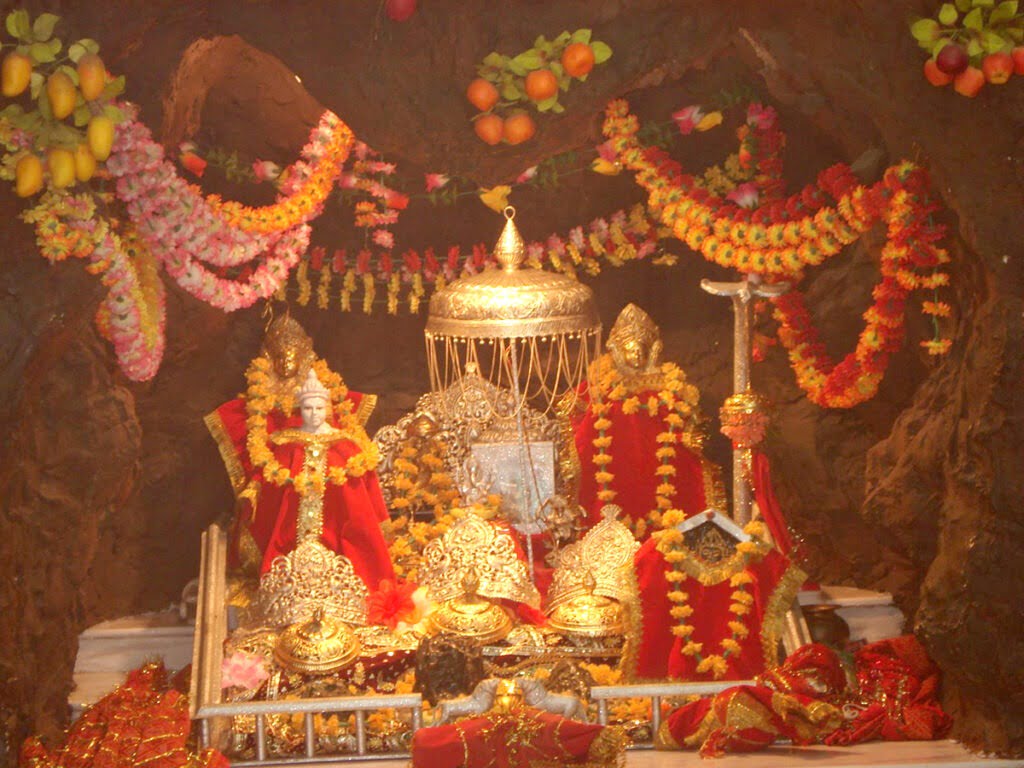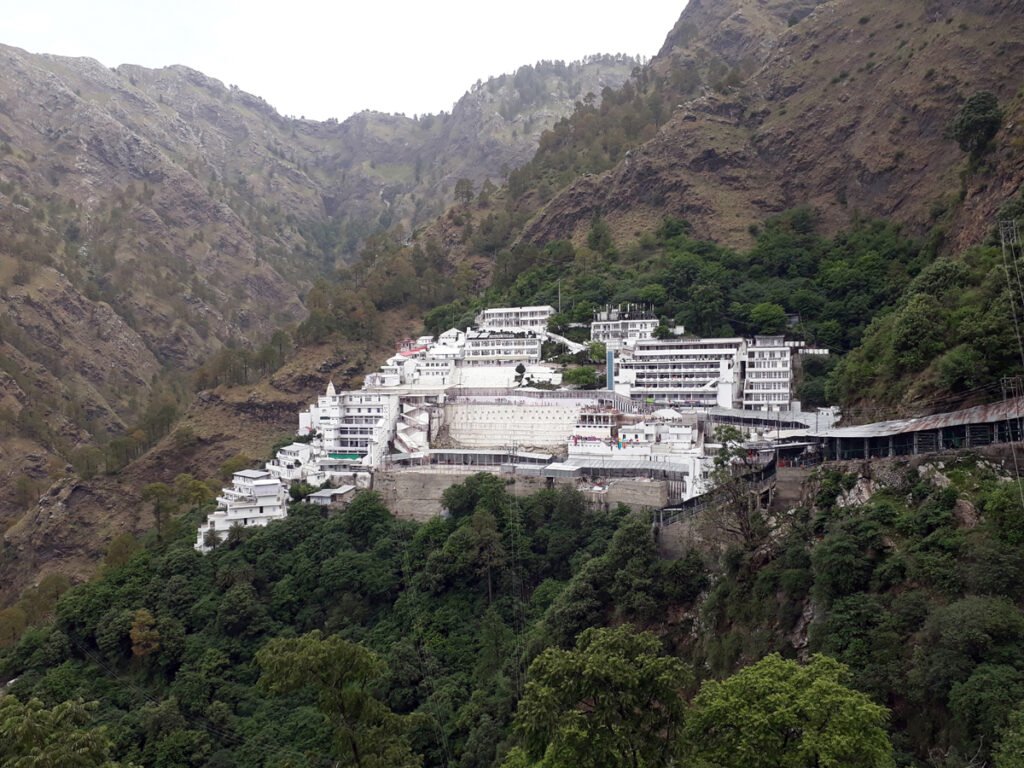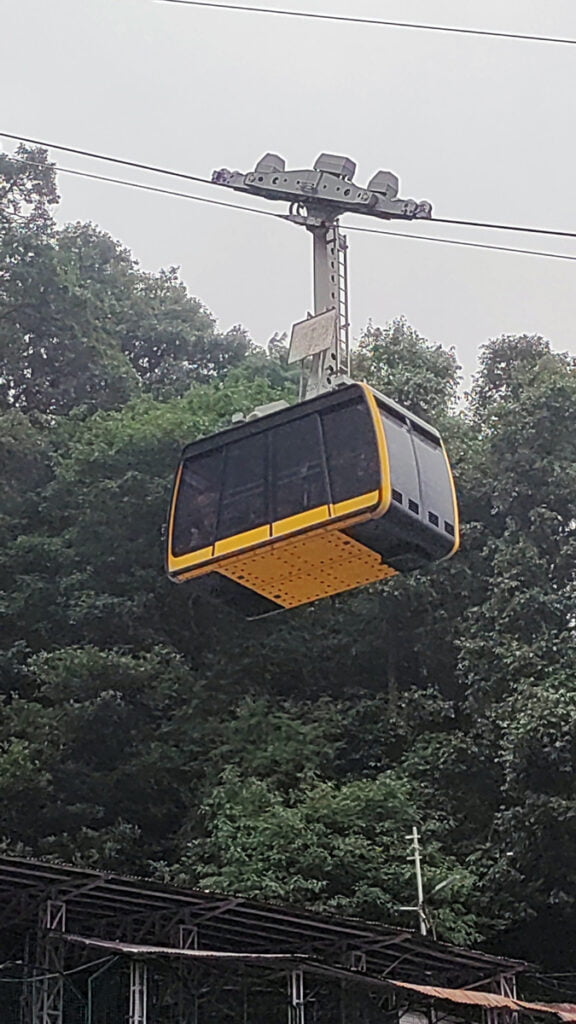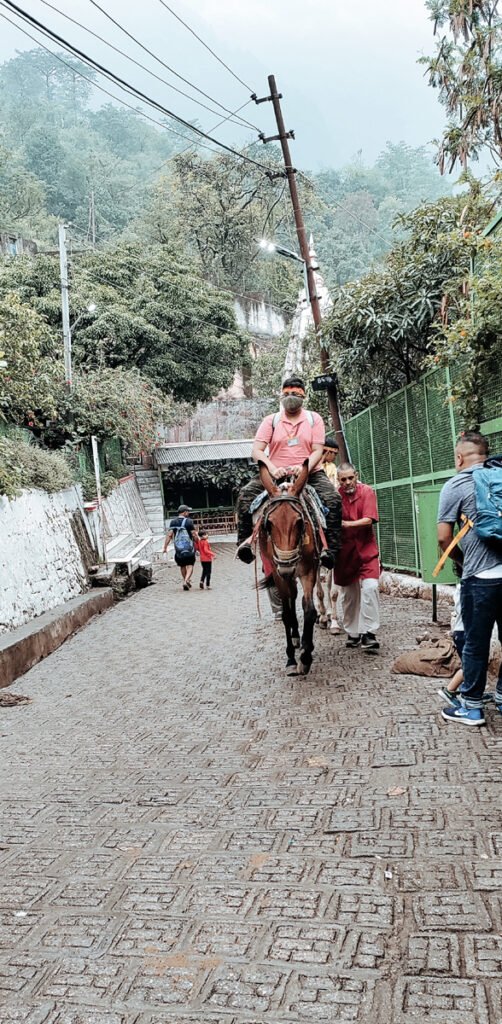Divine Mata Vaishno Devi Temple | Shaktipeeth Complete Guide
Vaishno Devi Temple, also known as Mata Vaishno Devi Temple, is a popular Hindu pilgrimage site located in the Trikuta Mountains in the northern Indian state of Jammu and Kashmir. It is one of the most visited religious sites in India and holds immense significance for devotees of the goddess Vaishno Devi.

Contents
- 1 Key features of the Vaishno Devi Temple:
- 2 Vaishno Devi Temple History:
- 3 Here’s a summarized version of the legend:
- 4 What is the story of three pindis in Vaishno Devi?
- 5 What is special about Vaishno Devi Temple?
- 6 Vaishno Devi Temple timing:
- 7 9 Places to Visit Near Vaishno Devi:
- 8 How to reach Vaishno Devi Temple:
- 9 Google Maps:
Key features of the Vaishno Devi Temple:
Location: The temple is situated at an altitude of approximately 5,200 feet (1,580 meters) above sea level in the Trikuta Mountains. It is about 12 kilometers from Katra, the base camp for the pilgrimage.
Goddess Vaishno Devi: The temple is dedicated to the goddess Vaishno Devi, who is believed to be an incarnation of the Hindu goddess Durga. The temple complex consists of three main caves, each representing the three forms of the goddess – Maha Kali, Maha Lakshmi, and Maha Saraswati.
Pilgrimage: The pilgrimage to Vaishno Devi Temple is considered highly sacred by Hindus. Devotees undertake the journey to seek the blessings of the goddess. The trek to the temple involves a steep uphill climb, and many pilgrims prefer to cover the distance by foot. However, there are also options for ponies, palanquins, and even a helicopter service for those who find it difficult to walk.
Bhavan: The Bhawan is the main temple complex where the deity’s idol is housed. It is located inside a cave and consists of a narrow passage. The idol of the goddess is a natural rock formation known as the “Pindis” and is worshipped with great devotion.
Aarti and Rituals: Various rituals, pujas (worship ceremonies), and aartis (devotional songs) are performed regularly at the temple. The atmosphere is charged with spiritual fervor, especially during festive seasons.
Festivals: The temple witnesses a huge influx of pilgrims during festivals like Navratri, when the goddess is believed to have manifested on Earth. During these times, the entire area is illuminated and decorated, creating a festive atmosphere.
Natural Beauty: The temple is located in a picturesque and serene setting. The journey to the temple provides breathtaking views of the surrounding mountains and landscapes.
Devotional Experience: The pilgrimage to Vaishno Devi Temple is not just about reaching the physical destination; it is also seen as a spiritual journey where devotees seek blessings, purification, and a sense of fulfillment.
Read More>> Badrinath Temple | Badrinarayan Temple

Vaishno Devi Temple History:
The history of the Vaishno Devi Temple is rooted in Hindu mythology and legends. The exact origins of the temple are not well-documented, but there are various stories associated with its creation and significance. One of the most famous legends involves the goddess Vaishno Devi taking the form of a young girl, slaying a demon named Bhairon Nath, and then meditating in the cave where the temple now stands.
Here’s a summarized version of the legend:
The Legend of Vaishno Devi:
According to the legend, Vaishno Devi was born as a mortal named Trikuta to a devout Brahmin couple. She was a devotee of Lord Vishnu from a young age. Trikuta decided to leave her home and meditate in the mountains to attain spiritual wisdom. Meanwhile, Bhairon Nath, a demon, became enamored with her beauty and started chasing her. To escape his pursuit, Trikuta entered a cave on the Trikuta Mountains.
Inside the cave, she took the form of the goddess Vaishno Devi and meditated for nine months. During this time, she assumed the form of Mahakali, Mahalakshmi, and Mahasaraswati – the three manifestations of the divine feminine. Finally, she emerged from the cave and encountered Bhairon Nath. She beheaded the demon, and Bhairon Nath realized his mistake and asked for forgiveness.
Vaishno Devi then shed her human form and transformed into a rock form. She then merged her three manifestations into a single divine form and entered the sanctum of the cave, where she resides as a spiritual presence. This cave is now the Vaishno Devi Temple.
Read More>> Char Dham Yatra – A Complete Guide to Spiritual Destination
Historical Evolution:
The recorded history of the temple dates back to the 11th century, and it has undergone several renovations and expansions over the centuries. The temple complex includes the main cave shrine and various facilities for pilgrims, such as accommodation, food, and medical services.
The popularity of the temple increased significantly in the modern era due to improved transportation and communication systems, which made it more accessible to pilgrims from across India and even abroad. The government and various religious organizations have also contributed to the development of the infrastructure around the temple.
Today, the Vaishno Devi Temple is a symbol of faith and devotion for millions of people. The pilgrimage to the temple involves a trek of about 13 kilometers from the base camp in Katra to the cave shrine, which is considered a spiritually enriching experience.

What is the story of three pindis in Vaishno Devi?
The story of the three pindis (also known as rocks or symbols) in the Vaishno Devi Temple is closely associated with the legend of the goddess Vaishno Devi herself. According to the legend, Vaishno Devi, an incarnation of the goddess Durga, meditated in the cave on the Trikuta Mountains. During her meditation, she assumed three distinct forms, each represented by a pindi, to destroy different demons and to fulfill a specific purpose.
Read More>> Enchanting Beauty of Madurai Meenakshi Amman Temple
Here’s the story of the three pindis:
Mahakali Pindi: As Vaishno Devi meditated in the cave, she assumed the form of Mahakali, the fierce and powerful manifestation of goddess Durga. In this form, she destroyed the demon Bhairon Nath, who had been pursuing her. This pindi represents her role as the fierce protector of her devotees and symbolizes the destruction of evil forces.
Mahalakshmi Pindi: After eliminating Bhairon Nath, Vaishno Devi assumed the form of Mahalakshmi, the goddess of wealth and prosperity. This form signifies her ability to bestow blessings and abundance upon her devotees. The Mahalakshmi pindi represents her benevolent and nurturing aspect.
Mahasaraswati Pindi: Lastly, Vaishno Devi transformed into the form of Mahasaraswati, the goddess of knowledge, wisdom, and learning. This form represents her role as the bestower of intellect and enlightenment. The Mahasaraswati pindi embodies her divine wisdom and guidance.
Together, these three pindis symbolize the trinity of goddesses – Mahakali, Mahalakshmi, and Mahasaraswati – each embodying a different aspect of the divine feminine energy. Devotees believe that by worshipping and seeking the blessings of these three pindis, they can gain protection, prosperity, and wisdom in their lives.
Read More>> Manasa Shakti Peeth Manasa Sarovar

What is special about Vaishno Devi Temple?
The Vaishno Devi Temple holds a special place in the hearts of millions of devotees due to several unique and significant aspects:
Sacred Cave Location: The temple is situated in a natural cave in the Trikuta Mountains, giving it a unique and ancient ambiance. The cave’s natural rock formations are preserved, and the temple’s architecture harmonizes with the cave’s environment. This natural setting adds to the spiritual and meditative atmosphere of the temple.
Three Manifestations of the Goddess: The temple is dedicated to the goddess Vaishno Devi, who is believed to manifest in three distinct forms: Mahakali, Mahalakshmi, and Mahasaraswati. The presence of these three pindis within the sanctum sanctorum makes the temple a powerful representation of the divine feminine energy in Hinduism.
Pilgrimage Journey: The journey to the temple involves a pilgrimage route that starts in Katra and covers a distance of around 13 kilometers on foot. This journey is seen as an act of devotion, self-purification, and penance. The path through the picturesque mountains is both physically challenging and spiritually enriching.
Massive Devotee Following: The temple draws millions of devotees from all over India and beyond, making it one of the most visited pilgrimage sites in the world. This massive following attests to the deep faith and devotion people have towards the goddess Vaishno Devi.
Spiritual Significance: Vaishno Devi is considered a wish-fulfilling deity, and many devotees visit the temple to seek her blessings for their desires, well-being, and protection. The temple holds a special place in the hearts of those who believe in the goddess’s divine intervention and grace.
Historical and Mythological Importance: The temple’s history and legends date back centuries, adding to its significance. The story of Vaishno Devi’s triumph over evil forces, her meditation in the cave, and her subsequent manifestations make for a captivating and spiritually uplifting narrative.
Unity of Different Beliefs: The temple attracts devotees from various religious backgrounds, transcending barriers of caste, creed, and religion. It serves as a unifying force that brings people together in their reverence for the goddess.
Festivals and Celebrations: The temple celebrates various Hindu festivals with great enthusiasm, including Navaratri, Diwali, and others. During these times, the temple complex comes alive with religious rituals, cultural performances, and a festive atmosphere.
Natural Beauty: The temple’s location in the picturesque Trikuta Mountains offers breathtaking views of the surrounding landscape. The journey to the temple is not only a spiritual experience but also a chance to immerse oneself in the beauty of nature.
Unique Rituals: The temple has its own set of rituals and traditions, including the offering of coconuts, bells, and other items to the goddess. These rituals contribute to the distinct spiritual ambiance of the temple.

Vaishno Devi Temple timing:
Vaishno Devi temple is open to the devotees throughout the year. The temple premises can be entered from 5 AM till 12 PM after which the temple is shut down, and again opened from 4 PM till 9 PM.
It is important to note that the temple is very popular and can get crowded, especially during the peak tourist season. Pilgrims are advised to book their tickets in advance to avoid long queues.
9 Places to Visit Near Vaishno Devi:
Bhairavnath Temple: After visiting the Vaishno Devi Temple, many pilgrims also visit the Bhairavnath Temple, which is dedicated to Bhairon Nath, the demon who was vanquished by Goddess Vaishno Devi. It’s situated about 2.5 kilometers from the main temple and offers panoramic views of the surrounding area.
Ardh Kuwari Cave: This cave is located midway on the pilgrimage route to Vaishno Devi Temple. It’s believed that Goddess Vaishno Devi meditated here for nine months before finally reaching the main cave. The cave is naturally formed and provides a unique spiritual experience.
Banganga Temple and Waterfall: This site is located in Katra, the base camp of the pilgrimage. The temple is dedicated to Goddess Banganga and is associated with a story from the Mahabharata. The area also features a waterfall and a pool where pilgrims can take a dip.
Jammu: The city of Jammu, often referred to as the “City of Temples,” is located not far from Katra. It has several important temples and historical sites, such as the Raghunath Temple complex, Ranbireshwar Temple, Bahu Fort, and the Amar Mahal Palace.
Shiv Khori: This cave shrine is dedicated to Lord Shiva and is located around 70 kilometers from Katra. It’s famous for a naturally formed stalagmite resembling Lord Shiva’s lingam. The cave is about 150 meters long and offers a unique spiritual experience.
Patnitop: About 80 kilometers from Katra, Patnitop is a hill station known for its natural beauty and panoramic views of the surrounding mountains. It’s a great place for trekking, picnics, and enjoying the cool climate.
Sanasar: Another nearby hill station, Sanasar is known for its lush green meadows and adventure activities like paragliding, trekking, and camping. It’s located about 20 kilometers from Patnitop.
Kud: Situated on the way to Patnitop, Kud is known for its picturesque landscapes, local cuisine, and shopping opportunities for traditional handicrafts.
Vaishno Devi Temple Helipad: If you’re short on time or prefer a quicker journey, you can opt for helicopter services from Katra to the Sanjichhat helipad near the Vaishno Devi Temple.
How to reach Vaishno Devi Temple:
By Air:
The nearest major airport is Jammu Airport, also known as Satwari Airport. It is well-connected to various cities in India.
From the airport, you can hire a taxi or take a bus to Katra, which is the base camp for the Vaishno Devi pilgrimage.
By Train:
Jammu Tawi Railway Station is the nearest major railhead. It is well-connected to several cities across India.
From the railway station, you can take a taxi, bus, or other modes of transportation to Katra.
By Road:
Katra is the starting point for the pilgrimage to the Vaishno Devi Temple. It is accessible by road from various cities in the region.
You can reach Katra by taking buses, taxis, or private vehicles.
From Katra to Vaishno Devi Temple:
The pilgrimage to the temple involves trekking from Katra to the temple complex, a distance of about 13 kilometers.
The pathway is well-paved and maintained, with resting points, refreshment stalls, and medical facilities along the route.
Devotees can choose to walk, or they can hire ponies, palanquins (palkis), or even use a helicopter service to reach the temple faster. The helicopter service operates between Katra and Sanjichhat, which is close to the temple.
Helicopter Service:
Helicopter services are available from Katra to Sanjichhat, which is a point closer to the Vaishno Devi Temple.
The helicopter ride provides a quicker way to reach the temple, particularly for those with physical limitations or time constraints.
The helicopter service needs to be booked in advance, and availability can vary.
Pony and Palanquin Services:
Pony (horse) and palanquin (palki) services are available for those who prefer not to walk the entire distance.
These services can be hired at Katra and will take you to the temple complex.
Online Booking and Yatra Parchi:
It’s advisable to obtain a “yatra parchi” (pilgrimage pass) before starting the trek. These can be obtained online or at the Yatra Registration Counter in Katra.
The yatra parchi helps in managing the flow of pilgrims and provides information about the number of devotees on the route.
